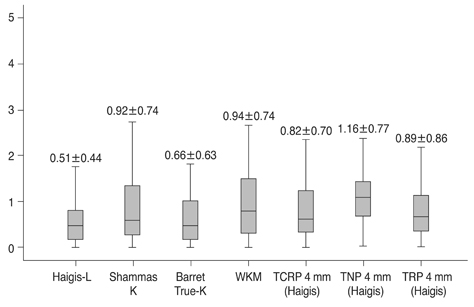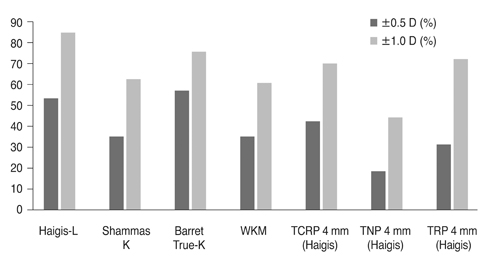Korean J Ophthalmol.
2018 Dec;32(6):497-505. 10.3341/kjo.2018.0008.
Comparison of Intraocular Lens Power Calculation Methods Following Myopic Laser Refractive Surgery: New Options Using a Rotating Scheimpflug Camera
- Affiliations
-
- 1Department of Ophthalmology, Samsung Medical Center, Sungkyunkwan University School of Medicine, Seoul, Korea. tychung@skku.edu
- 2SNU Seoul Eye Clinic, Seoul, Korea.
- KMID: 2427965
- DOI: http://doi.org/10.3341/kjo.2018.0008
Abstract
- PURPOSE
To evaluate and compare published methods of calculating intraocular lens (IOL) power following myopic laser refractive surgery.
METHODS
We performed a retrospective review of the medical records of 69 patients (69 eyes) who had undergone myopic laser refractive surgery previously and subsequently underwent cataract surgery at Samsung Medical Center in Seoul, South Korea from January 2010 to June 2016. None of the patients had pre-refractive surgery biometric data available. The Haigis-L, Shammas, Barrett True-K (no history), Wang-Koch-Maloney, Scheimpflug total corneal refractive power (TCRP) 3 and 4 mm (SRK-T and Haigis), Scheimpflug true net power, and Scheimpflug true refractive power (TRP) 3 mm, 4 mm, and 5 mm (SRK-T and Haigis) methods were employed. IOL power required for target refraction was back-calculated using stable post-cataract surgery manifest refraction, and implanted IOL power and formula accuracy were subsequently compared among calculation methods.
RESULTS
Haigis-L, Shammas, Barrett True-K (no history), Wang-Koch-Maloney, Scheimpflug TCRP 4 mm (Haigis), Scheimpflug true net power 4 mm (Haigis), and Scheimpflug TRP 4 mm (Haigis) formulae showed high predictability, with mean arithmetic prediction errors and standard deviations of −0.25 ± 0.59, −0.05 ± 1.19, 0.00 ± 0.88, −0.26 ± 1.17, 0.00 ± 1.09, −0.71 ± 1.20, and 0.03 ± 1.25 diopters, respectively.
CONCLUSIONS
Visual outcomes within 1.0 diopter of target refraction were achieved in 85% of eyes using the calculation methods listed above. Haigis-L, Barrett True-K (no history), and Scheimpflug TCRP 4 mm (Haigis) and TRP 4 mm (Haigis) methods showed comparably low prediction errors, despite the absence of historical patient information.
MeSH Terms
Figure
Reference
-
1. Klein BE, Klein R, Lee KE, Gangnon RE. Incidence of age-related cataract over a 15-year interval the Beaver Dam Eye Study. Ophthalmology. 2008; 115:477–482.2. Koch DD. New options for IOL calculations after refractive surgery. J Cataract Refract Surg. 2006; 32:371–372.
Article3. Seitz B, Langenbucher A, Nguyen NX, et al. Underestimation of intraocular lens power for cataract surgery after myopic photorefractive keratectomy. Ophthalmology. 1999; 106:693–702.
Article4. Seitz B, Langenbucher A. Intraocular lens power calculation in eyes after corneal refractive surgery. J Refract Surg. 2000; 16:349–361.
Article5. Hoffer KJ. Intraocular lens power calculation after previous laser refractive surgery. J Cataract Refract Surg. 2009; 35:759–765.
Article6. Wang L, Hill WE, Koch DD. Evaluation of intraocular lens power prediction methods using the American Society of Cataract and Refractive Surgeons Post-Keratorefractive In traocular Lens Power Calculator. J Cataract Refract Surg. 2010; 36:1466–1473.7. McCarthy M, Gavanski GM, Paton KE, Holland SP. Intraocular lens power calculations after myopic laser refractive surgery: a comparison of methods in 173 eyes. Ophthalmology. 2011; 118:940–944.
Article8. Savini G, Barboni P, Carbonelli M, et al. Intraocular lens power calculation after myopic excimer laser surgery: Selecting the best method using available clinical data. J Cataract Refract Surg. 2015; 41:1880–1888.
Article9. Haigis W. Intraocular lens calculation after refractive surgery for myopia: Haigis-L formula. J Cataract Refract Surg. 2008; 34:1658–1663.
Article10. Shammas HJ, Shammas MC. No-history method of intraocular lens power calculation for cataract surgery after myopic laser in situ keratomileusis. J Cataract Refract Surg. 2007; 33:31–36.
Article11. Barrett GD. Intraocular lens calculation formulas for new intraocular lens implants. J Cataract Refract Surg. 1987; 13:389–396.
Article12. Barrett GD. An improved universal theoretical formula for intraocular lens power prediction. J Cataract Refract Surg. 1993; 19:713–720.
Article13. Abulafia A, Hill WE, Koch DD, et al. Accuracy of the Barrett True-K formula for intraocular lens power prediction after laser in situ keratomileusis or photorefractive keratectomy for myopia. J Cataract Refract Surg. 2016; 42:363–369.
Article14. Wang L, Booth MA, Koch DD. Comparison of intraocular lens power calculation methods in eyes that have undergone LASIK. Ophthalmology. 2004; 111:1825–1831.
Article15. Gale RP, Saldana M, Johnston RL, et al. Benchmark standards for refractive outcomes after NHS cataract surgery. Eye (Lond). 2009; 23:149–152.
Article16. Masket S, Masket SE. Simple regression formula for intraocular lens power adjustment in eyes requiring cataract surgery after excimer laser photoablation. J Cataract Refract Surg. 2006; 32:430–434.
Article17. Hodge C, McAlinden C, Lawless M, et al. Intraocular lens power calculation following laser refractive surgery. Eye Vis (Lond). 2015; 2:7.
Article18. Wang L, Mahmoud AM, Anderson BL, et al. Total corneal power estimation: ray tracing method versus gaussian optics formula. Invest Ophthalmol Vis Sci. 2011; 52:1716–1722.
Article19. Savini G, Hoffer KJ, Carbonelli M, Barboni P. Scheimpflug analysis of corneal power changes after myopic excimer laser surgery. J Cataract Refract Surg. 2013; 39:605–610.
Article20. Holladay JT, Hill WE, Steinmueller A. Corneal power measurements using scheimpflug imaging in eyes with prior corneal refractive surgery. J Refract Surg. 2009; 25:862–868.
Article21. Savini G, Barboni P, Carbonelli M, Hoffer KJ. Comparison of methods to measure corneal power for intraocular lens power calculation using a rotating Scheimpflug camera. J Cataract Refract Surg. 2013; 39:598–604.
Article22. Tang M, Li Y, Huang D. An intraocular lens power calculation formula based on optical coherence tomography: a pilot study. J Refract Surg. 2010; 26:430–437.
Article23. Wang L, Tang M, Huang D, et al. Comparison of newer intraocular lens power calculation methods for eyes after corneal refractive surgery. Ophthalmology. 2015; 122:2443–2449.
Article24. Kim EC, Cho K, Hwang HS, et al. Intraocular lens prediction accuracy after corneal refractive surgery using K values from 3 devices. J Cataract Refract Surg. 2013; 39:1640–1646.
Article25. Kim SW, Kim EK, Cho BJ, et al. Use of the pentacam true net corneal power for intraocular lens calculation in eyes after refractive corneal surgery. J Refract Surg. 2009; 25:285–289.26. Yi JH, Shin JY, Ha BJ, et al. The comparison of central and mean true-net power (Pentacam) in calculating IOL-power after refractive surgery. Korean J Ophthalmol. 2009; 23:1–5.
Article
- Full Text Links
- Actions
-
Cited
- CITED
-
- Close
- Share
- Similar articles
-
- Intraocular Lens Power Calculation Using Shammas-PL Formula after Laser In-situ Keratomileusis
- Intraocular Lens Power Calculation in Cataract Surgery after Excimer Laser Photorefractive Keratectomy
- Intraocular Lens Power Calculation According to the Difference between Anterior and Total Keratometry Using Scheimpflug Imaging
- Surgical treatment for myopia
- Comparison of Intraocular Lens Power Calculation Methods after Refractive Surgery Provided by the ASCRS




